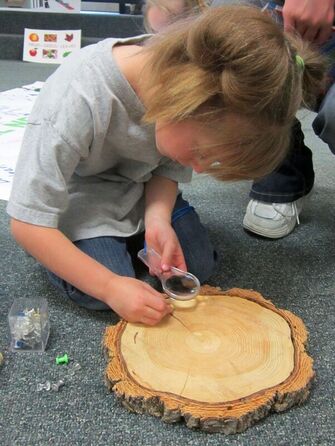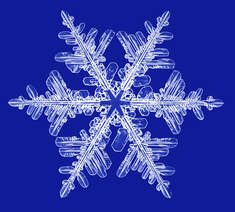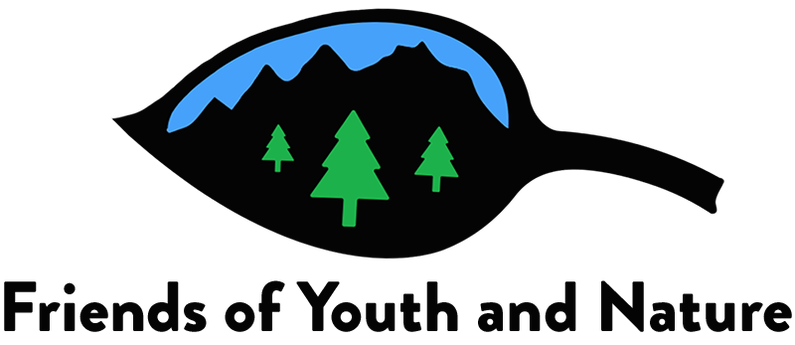|
Tips to help you connect your family to nature!
|
Nature can be a great outdoor classroom for our children. It is a win anytime you take a child on a field trip in a forest or local park, but it is even more of a bonus when you can tie an outdoor adventure with something they are learning in school—like math! Math can be very hard and abstract for some children to understand, but finding actual physical items can help make sense of the concepts. You might be surprised to learn that many objects in nature relate to math. Here are some ideas to get you started in helping your child observe and discover math in nature on your next outdoor adventure. What child does not like water? Find a pond, puddle or river, and drop a pebble in. What do you see? The ripple effect is a concentric circle. The circles seem to grow and get bigger and bigger. Concentric circles are different sizes but originate from the same center point. You can also find this on a tree stump. The rings on the tree stump are not just the age of the tree, but are circles that originate from the same center point. Finding a spider web for some is quite frightening, but take a closer long look at the web. It also has concentric circles. Can you think of a food that is used in lots of your favorite family recipes? Onions. They are not great to eat by themselves, but fun to explore the circles. The Fibonacci Sequence was discovered by and named for a 12th century Italian mathematician. The sequence is a series of numbers where the next number is the sum of the previous two numbers. For example, 1, 1, 2, 3, 5, 8, 13, 21, 34, 55, 89, 144 … This sequence of numbers pops up in nature. Have any ideas where? Take a closer look at some of those beautiful wild flowers that will be popping out in a few months. Count the petals on a sunflower, a black-eyed Susan or a daisy. Do the numbers look familiar? Sunflowers most often have 55, 89 or 144 petals. Black-eyed Susan’s often have 13 and daisies have 34 to 89. Related to the Fibonacci Sequence is another math concept called the Golden Ratio. Finding examples of the Golden Ratio is not hard. It can be as simple as a houseplant or as complex as an expansive spiral in the galaxy. The Golden Ratio is tied to the numerical pattern discussed above. Take two consecutive Fibonacci numbers, then divide the second by the first and this quotient will approximate the Golden Ratio as the Fibonacci numbers get bigger and bigger (144/89 = 1.61798 while the Golden Ratio is approximately 1.61803). The ratio of the length to the width of a Golden Rectangle is approximately 1.61803. Golden Rectangles occur everywhere in nature. If you measure your arm length and divide it by your shoulder width then you will probably get a result that is very close to 1.618 or the Golden Ratio! How many other examples of this phenomenon can you find? When the Golden Ratio is applied as a growth factor you get a type of logarithmic spiral known as the Golden Spiral. Some cool examples are the chameleon tail, sea shells, ammonite fossils, ocean waves, flower buds, snail shells, whirlpools, pine cones, sunflower seed heads and hurricanes to name a few. Fractals are another intriguing mathematical shape that we can find in nature. A fractal is a self-similar, repeating shape. This means the same basic shape is seen again and again in the shape itself. Mathematically, they can be created by seeding iterative functions with random complex numbers. Now, ask yourself where can I find these? They occur just about anywhere in nature such as ferns, trees, roots, snowflakes, frosted car windshields, leaves, patterns of streams, rivers, coastlines, mountains, waves and waterfalls.
These all seem a bit complex, but it’s fun to explore the numbers behind them. Let’s talk about something a bit more practical for some. When walking on trails do you ever wonder how tall the trees are? One method of indirect measurement involves measuring the shadows cast by objects. Here is how it works. If a 6-foot man casts a 4-foot shadow then a 60-foot tree would cast a 40-foot shadow assuming that the man and the tree’s shadows are measured at the same time and same place. This is an application of similar triangles. The angle of elevation of the sun is the same for both the man and the tree while the altitude is perpendicular to the horizontal and, because these two angles are congruent, the triangles are similar and, therefore, their sides must be in proportion. So, if a 5-foot girl casts a 4-foot shadow and a beautiful Colorado Blue Spruce casts an 80-foot shadow, then the tree must be 100 feet tall! How do you measure the height of tall trees on a cloudy day? Well, that is an application of trigonometry and a topic that can be easily researched on a rainy day.
If you are interested in exploring nature and how it relates back to math, do a quick search on the internet. You can find all levels of fascinating information. Then take your new found knowledge outside and start exploring and observing.
2 Comments
|
Blogs for Summer! DIY Summer Camps A Summer backyard Bucket List Hiking with Children 101 Kids, Dogs and Hikes a Winning Combination Getting Outdoors is Easier than You Think Categories
All
Archive
Archives
July 2024
|




 RSS Feed
RSS Feed


